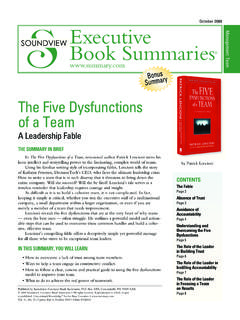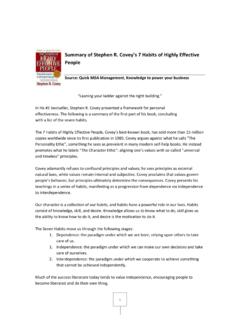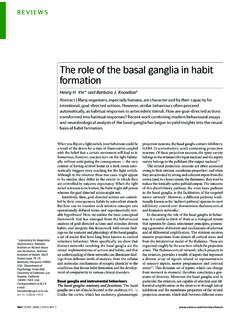Transcription of THE POWER OF HABIT - Amazon Web Services
1 THE POWER OF HABIT Why We Do What We Do in Life and Business by Charles Duhigg Subject Area: Management CONTENTS 1. Part 1: The habits of Individuals 2. The HABIT Loop 3. The Craving Brain 4. The Golden Rule of HABIT Change 5. Part 2: The habits of Successful Organizations 6. Part 3: The habits of Societies 7. The Neurology of Free Will THE SUMMARY IN BRIEF In The POWER of HABIT , Charles Duhigg, award-winning business reporter for The New York Times, takes us to the thrilling edge of scientific discoveries that explain why habits exist and how they can be changed. By distilling vast amounts of information into engrossing narratives, Duhigg brings to light a whole new understanding of human nature and its potential for transformation. Along the way, we learn why some people and companies struggle to change, despite years of trying, while others seem to remake themselves overnight.
2 We visit laboratories where neuroscientists explore how habits work and where they reside in our brains. We discover how the right habits were crucial to the successful promotion of Pepsodent; to Tony Dungy who led his team to a Super Bowl win by changing one step in his players HABIT loop; and to Alcoa when it turned itself around by changing just one routine within the organization. At its core, The POWER of HABIT contains an exhilarating argument: The key to exercising regularly, losing weight, raising exceptional children, becoming more productive, building revolutionary companies and social movements, and achieving success is understanding how habits work. By harnessing this new science, we can transform our businesses, our communities and our lives. IN THIS SUMMARY, YOU WILL LEARN: Why the brain tries to make routines into habits . How cravings create and POWER new habits . How to apply the golden rule of HABIT change.
3 What keystone habits are and the importance of them in creating a new routine. INTRODUCTION When you woke up this morning, what did you do first? Did you hop in the shower, check your email or grab a doughnut from the kitchen counter? Did you brush your teeth before or after you toweled off? Which route did you drive to work? When you got home, did you put on your sneakers and go for a run, or pour yourself a drink and eat dinner in front of the TV? All our life, so far as it has definite form, is but a mass of habits , William James wrote in 1892. Most of the choices we make each day may feel like the products of well-considered decision making, but they re not. They re habits . And though each HABIT means relatively little on its own, over time, the meals we order, whether we save or spend, how often we exercise, and the way we organize our thoughts and work routines have enormous impacts on our health, productivity, financial security and happiness.
4 One paper published by a Duke University researcher in 2006 found that more than 40 percent of the actions people performed each day weren t actual decisions, but habits . James like countless others, from Aristotle to Oprah spent much of his life trying to understand why habits exist. But only in the past two decades have scientists and marketers really begun understanding how habits work and, more important, how they change. At one point, we all consciously decided how much to eat and what to focus on when we got to the office, how often to have a drink or when to go for a jog. Then we stopped making a choice, and the behavior became automatic. It s a natural consequence of our neurology. And by understanding how it happens, you can rebuild those patterns in whichever way you choose. PART I: THE habits OF INDIVIDUALS THE HABIT LOOP: HOW habits WORK Within the building that houses the Brain and Cognitive Sciences department of the Massachusetts Institute of Technology (MIT) are laboratories that contain what, to the casual observer, look like dollhouse versions of surgical theaters.
5 There are tiny scalpels, small drills, and miniature saws less than a quarter inch wide attached to robotic arms. Even the operating tables are tiny, as if prepared for child-sized surgeons. Inside these laboratories, neurologists cut into the skulls of anesthetized rats, implanting tiny sensors that can record the smallest changes inside their brains. These laboratories have become the epicenter for a quiet revolution in the science of HABIT formation, and the experiments unfolding explain how we develop the behaviors necessary to make it through each day. The rats in these labs have illuminated the complexity that occurs inside our heads whenever we do something as mundane as brush our teeth or back the car out of the driveway. Toward the center of the skull is a golf ball-sized lump of tissue that is similar to what you might find inside the head of a fish, reptile or mammal. This is the basal ganglia, an oval of cells that, for years, scientists didn t understand very well, except for suspicions that it played a role in diseases, such as Parkinson s.
6 In the early 1990s, the MIT researchers began wondering if the basal ganglia might be integral to habits as well. They noticed that animals with injured basal ganglia suddenly developed problems with tasks, such as learning how to run through mazes or remembering how to open food containers. They decided to experiment by employing new micro-technologies that allowed them to observe, in minute detail, what was occurring within the heads of rats as they performed dozens of routines. Ultimately, each animal was placed into a T-shaped maze with chocolate at one end. The maze was structured so that a rat was positioned behind a partition that opened when a loud click sounded. Initially, when the rat heard the click and saw the partition disappear, it would usually wander up and down the center aisle, sniffing in corners and scratching at walls. It appeared to smell the chocolate, but couldn t figure out how to find it. When it reached the top of the T, it often turned to the right, away from the chocolate, and then wandered left, sometimes pausing for no obvious reason.
7 Eventually, most animals discovered the reward. But there was no discernable pattern in their meanderings. It seemed as if each rat was taking a leisurely, unthinking stroll. The probes in the rats heads, however, told a different story. While each animal wandered through the maze, its brain and in particular, its basal ganglia worked furiously. Each time a rat sniffed the air or scratched a wall, its brain exploded with activity, as if analyzing each new scent, sight and sound. The rat was processing information the entire time it meandered. The scientists repeated the experiment, again and again, watching how each rat s brain activity changed as it moved through the same route hundreds of times. A series of shifts slowly emerged. The rats stopped sniffing corners and making wrong turns. Instead, they zipped through the maze faster and faster. And within their brains, something unexpected occurred: As each rat learned how to navigate the maze, its mental activity decreased.
8 As the route became more and more automatic, each rat started thinking less and less. It was as if the first few times a rat explored the maze, its brain had to work at full POWER to make sense of all the new information. But after a few days of running the same route, the rat didn t need to scratch the walls or smell the air anymore, and so the brain activity associated with scratching and smelling ceased. It didn t need to choose which direction to turn, and so decision-making centers of the brain went quiet. The rat had internalized how to sprint through the maze to such a degree that it hardly needed to think at all. But that internalization relied upon the basal ganglia, the brain probes indicated. This tiny, ancient neurological structure seemed to take over as the rat ran faster and faster and its brain worked less and less. The basal ganglia was central to recalling patterns and acting on them. The basal ganglia, in other words, stored habits even while the rest of the brain went to sleep.
9 The Automatic Routine of Chunking This process in which the brain converts a sequence of actions into an automatic routine is known as chunking, and it s at the root of how habits form. There are dozens if not hundreds of behavioral chunks that we rely on every day. Some are simple: You automatically put toothpaste on your toothbrush before sticking it in your mouth. Some, such as getting dressed or making the kids lunch, are more complex. habits , scientists say, emerge because the brain is constantly looking for ways to save effort. Left to its own devices, the brain will try to make almost any routine into a HABIT , because habits allow our minds to ramp down more often. This effort-saving instinct is a huge advantage. An efficient brain allows us to stop thinking constantly about basic behaviors, such as walking and choosing what to eat, so we can devote mental energy to inventing spears, irrigation systems and, eventually, airplanes and video games.
10 The process within our brains is a three-step loop. First, there is a cue, a trigger that tells your brain to go into automatic mode and which HABIT to use. Then there is the routine, which can be physical, mental or emotional. Finally, there is a reward, which helps your brain figure out if this particular loop is worth remembering for the future. Over time, this loop cue, routine, reward; cue, routine, reward becomes more and more automatic. The cue and reward become intertwined until a powerful sense of anticipation and craving emerges. Eventually, a HABIT is born. habits aren t destiny. habits can be ignored, changed, or replaced. But the reason the discovery of the HABIT loop is so important is that it reveals a basic truth: When a HABIT emerges, the brain stops fully participating in decision making. It stops working so hard, or diverts focus to other tasks. So unless you deliberately fight a HABIT unless you find new routines the pattern will unfold automatically.












